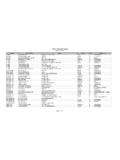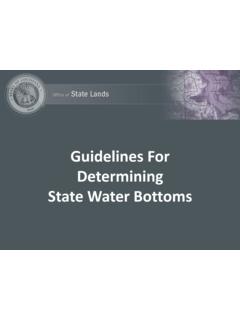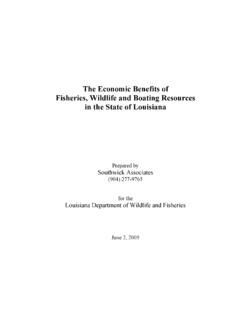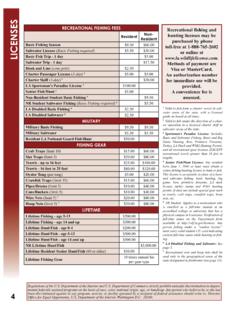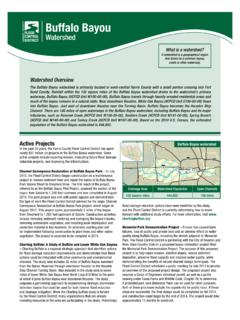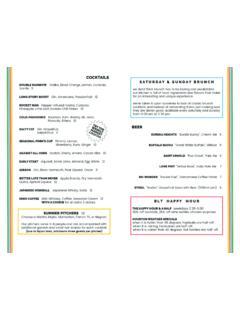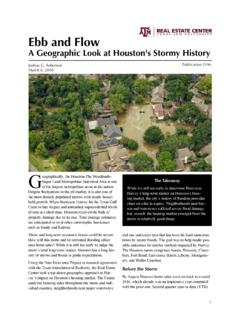Transcription of 2. Aquatic Systems: a. Freshwater
1 STATE OVERVIEW LA CWCS--DEC 2005 23 2. Aquatic Systems: a. Freshwater Louisiana s abundant bayous, rivers, lakes, reservoirs, and wetlands provide unlimited fishing, hunting, boating and recreational opportunities and are a major contributor to the state s wealth and economic growth. Today, Aquatic habitats are in high demand as sources of domestic water supplies, irrigation for agriculture, and wastewater treatment. A growing proportion of Louisiana s population is beginning to appreciate the importance of our Aquatic habitats as nursery areas for our commercial and sport fisheries. They are beginning to fully understand the problems of balancing biological and recreational uses with agriculture and urban needs, navigation, flood control, and waste water disposal. Louisiana has more surface water available (84%) than any other state (XU 2004) and contains over 66,294 miles of rivers and streams, 1,078,031 acres (1,684 square miles) of lakes and reservoirs, 5,550,951 acres (9,191 square miles) of fresh and tidal wetlands and 4,899,840 acres (7,656 square miles) of estuaries (LDEQ 2004).
2 The Mississippi River and its major tributary the Red River, along with other major river systems (Ouachita, Black, Calcasieu, Atchafalaya, Sabine, Pearl, and Mermentau), combine to incorporate more than 2,300 miles of navigable waterways. The Mississippi drainage basin covers approximately million square miles which represents 41% of the conterminous United States and 1/8 of North America. Combined with the Atchafalaya River basin, these two river systems are habitat for 195 species of native Freshwater fish which represents almost 1/3 of the Freshwater fish species in North America (Fremling et al. 1989). In addition, both river systems are habitat for over 40 species of marine fish. They also serve as conduits for the spread of invasive animal species such as the Rio Grande cichlid, Zebra mussel, and five species of Asian carp (LDWF 2004b).
3 A vast array of levees have been constructed for flood protection and to channelize the water flow in the rivers. Louisiana has more than 2,000 miles of levees as well as other flood control devices along these rivers. The present condition of Red and Pearl Rivers are heavily influenced by the locks and dams constructed for navigation and to control water levels. The Red River has a total of 5 lock and dam systems constructed between the Arkansas line and it s outfall at the Mississippi River. The Sabine, Pearl, Atchafalaya, and Black Rivers have all undergone alterations to their natural flow regime. There are roughly 488 lakes, ponds, and man-made reservoirs in Louisiana. These water bodies account for nearly million surface acres of water. The largest of these is Lake Pontchartrain with a surface acreage that covers 621 square miles and totals 397,000 acres.
4 Toledo Bend Reservoir located on the Louisiana/Texas border is the largest man-made body of water in the South and fifth largest in surface acres in the United States. The reservoir covers 186,000 acres and has a controlled storage capacity of 4,477,000 acre-feet ( trillion gallons). The reservoir was formed when the Sabine STATE OVERVIEW LA CWCS--DEC 2005 24 River was impounded for hydroelectric purposes, water supply, and recreation. Many of the states lakes are small natural oxbows, which are remnants of rivers after they have altered their course. b. Water Quality Assessments: The Louisiana Department of Environmental Quality (LDEQ) completed sampling of all twelve of Louisiana s watershed management basins in 2002. A total of 479 water body management subsegments within the state were monitored once per month for a full year (LDEQ 2004).
5 Designated use categories for the waters of Louisiana are: agriculture, drinking water supply, ecological significance, fish and wildlife propagation, outstanding natural resource, oyster production, and primary and secondary contact recreation. Water quality assessments for fish and wildlife propagation for the 4 major water body categories in Louisiana are listed in Table Some of the major causes for water bodies not supporting their designated uses are: fecal coliform, dissolved oxygen, total suspended solids, turbidity, siltation, metals, pesticides, and total dissolved solids. For the water quality assessments given for each basin in Chapter 4, only the three primary designated uses recognized by LDEQ for most waters of the state are addressed. These 3 designated uses are primary contact recreation (swimming), secondary contact recreation (boating), and fish and wildlife propagation (fishing).
6 C. Louisiana s Natural and Scenic Rivers: Louisiana s Natural and Scenic River system ( system ) is one of the nation s largest, oldest, most diverse, and unique state river protection initiatives. It encompasses 51 streams or stream segments and is over 3,300 miles in length (Jenkins and Cascio 2000) (Fig. , Table ). In the early 1970 s the Louisiana Natural and Scenic River Act (Act) was passed, creating the system which sets certain requirements for a river to meet for inclusion in the program. The Act also established a regulatory component, and designated the LDWF Secretary to administer the system . The streams and rivers included in the system are protected through a permitting process and certain prohibitions mandated by the Act. Certain activities which would STATE OVERVIEW LA CWCS--DEC 2005 25 drastically alter the natural and scenic qualities of rivers in the system are prohibited.
7 These activities include: Channelization Channel realignment Clearing and snagging Impoundment construction Commercial clearcutting of timber within 100 feet of the low water mark Other activities that may have a direct, significant ecological impact on the river must be permitted by LDWF, and the permit application must also be reviewed by LDEQ, Department of Agriculture and Forestry (LDAF), Department of Culture, Recreation and Tourism (CRT), and the Office of State Planning. Activities that must be permitted include, but are not limited to: Bridge, pipeline and power line crossings Bulkheads, piers, dock and ramp construction Waste water discharges Land development adjacent to the river d. Management Basins: Louisiana has twelve water quality management basins delineated on the basis of the natural drainage patterns of the state s major river basins (Fig.)
8 Each water quality management basin is subdivided into stream segments in which the hydraulic and water quality characteristics are fairly constant. Land use in the basins is dominated by forestry STATE OVERVIEW LA CWCS--DEC 2005 26 and agriculture although the percentage of urban use is considerable in the Pontchartrain Basin (Table ). The Pearl and Pontchartrain Basins have the highest Aquatic species diversity, relative to their area, in the state and, along with the Ouachita Basin, contain the highest number of species of conservation concern (Table ). Figure Aquatic basins in Louisiana. STATE OVERVIEW LA CWCS--DEC 2005 27 1. Atchafalaya Basin The Atchafalaya River Basin is located in south-central Louisiana. The Atchafalaya River, a distributary of the Red, Black, and Mississippi Rivers, presently carries about 30 percent of the Mississippi s flow.
9 The basin is well-defined by a system of levees which surround it on the north, east, and west. The entire basin serves as a major floodway for the Mississippi River floodwaters. The Atchafalaya Basin is predominantly bottomland hardwoods and cypress-tupelo swamp with some Freshwater marshes in the lower distributary area. It constitutes the largest contiguous Freshwater swamp in the United States. 2. Barataria Basin The Barataria Basin lies in the eastern coastal region of the state. This basin is bounded on the north and east by the lower Mississippi River, on the west by bayou Lafourche, and on the south by the Gulf of Mexico. The major receiving waterbody in this basin is Barataria Bay. The Barataria Basin consists largely of bottomland hardwoods and fresh to brackish marshes, having some saline marsh on the fringes of Barataria Bay.
10 Elevations in this basin range from minus two feet to four feet above sea level. 3. Calcasieu Basin The Calcasieu River Basin is located in southwestern Louisiana and is aligned in a north-south direction. Headwaters of the Calcasieu River are in the hills west of Alexandria. The river flows south for about 160 miles to the Gulf of Mexico. The mouth of the river is about 30 miles east of the Texas Louisiana state line. The landscape in this basin varies from pine-forested hills in the upper end to brackish and salt marshes in the lower reaches around Calcasieu Lake. 4. Mermentau Basin The Mermentau River Basin is located in southwestern Louisiana and encompasses the prairie region of the state and a section of the coastal zone. The Mermentau River Basin is bounded on the north and east by the Vermilion Teche River Basin, on the west by the Calcasieu River Basin, and on the south by the Gulf of Mexico.
